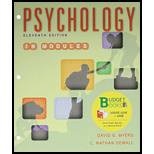
Concept introduction: Psychotherapy is the treatment of individuals through psychological methods used to help the patient change and overcome problems in a preferred way. The main aim of this treatment is to maintain the mental health and well-being of the individual.
Answer to Problem 13TYS
Correct answer: The most enthusiastic or optimistic view of the effectiveness of psychotherapy comes from reports of clinicians and clients. Hence, option c. is the correct answer.
Explanation of Solution
Reasons for correct statement:
Option c. is given as “reports of clinicians and clients”. The effectiveness of the psychotherapy is comes from the reports of clinicians and clients. Meta-data analysis is a procedure that contains conclusions of different studies. Reports of effective treatment are notes that emphasize the transformation from unhappiness to mental well-being of a patient. The effective treatments include a psychologist’s perspective, clients’ values, characteristics, culture, and other preferences. Hence, option c. is the correct answer.
Reasons for incorrect statement:
Option a. is given as “outcome research”. In outcome research, the factors of successful therapy are grouped and ordered. The improvement results from a client’s expectation benefits the effectiveness of the therapy. However, this is not an optimistic view of effective psychotherapy. Hence, option a. is incorrect.
Option b. is given as “Randomized clinical trials”. Researchers assign and group the people randomly on a waiting list “for therapyˮ and “not for therapyˮ. Then, they evaluate everyone and compare the outcomes with assessments from others who do not have knowledge regarding their therapy. Thus, this is affects the effectiveness of psychotherapy. Hence, option b. is incorrect.
Option d. is given as “a government study of treatment for depression”. Government study of treatment for depression is to support the mental health of individuals. This treatment needs evidence-based practice to make it effective. Hence, option d. is incorrect.
Therefore, options a., b., and d. are incorrect.
Want to see more full solutions like this?
Chapter 55 Solutions
Bundle: Loose-leaf Version for Psychology in Modules 11e & LaunchPad for Myers' Psychology in Modules 11e (Six Month Access)
- How can social workers contribute to prison or criminal justice reform efforts and initiatives? Please cite in text source and list references.arrow_forwardCriminological theory support drunk driving appropriatenessarrow_forwardthe capacity to still feel wonder in essential for the creative processarrow_forward
- How does music influence your emotions? Can you recall a specific song or piece of music that has evoked strong emotions in you? What was it about that music that elicited such a response? Instructions: Recall a song that evoked strong emotions What emotions did the song help you feel? and why? Are there specific musical elements (e.g., melody, rhythm, harmony, lyrics) that you find particularly powerful in shaping emotional experiences? How do these elements contribute to the overall emotional impact of a piece of music?arrow_forwardAnalyzed the relevant state or federal policies and drunk driving related to criminological theory, focus on specific needs of the public and the relevant branch of the criminal justice system in the center of the departmental policy justifying your identicationsarrow_forwardn which sentence is the comma optional? Zach, no doubt, has a reasonable explanation for not setting the table for dinner. Since I grew up in a nearby community, I would prefer to live near Topeka, Kansas. Let’s get an opinion from Emily Bassett, who has experience in training others. Before reading the sign, I didn’t guess that the gadget on the counter was a toaster.arrow_forward
- How does poverty affect people? How does poverty affect our society? Do you think anti-poverty strategies are an important part of a social welfare system? Why? Please cite in text source and list referencesarrow_forwardGiven the following request to an AI chatbot, which response is better? (You can use Google to check the accuracy of each response.) Prompt Write a love poem about someone longing for a sandwich. Make it a sonnet, and give it a tone that straddles a serious love poem and whimsy appropriate for a poem about a sandwich. Response Response A Response B Oh, sandwich, where art thou, my bread?I love you, your ham, your cheese.My stomach rumbles and my tummy grumbles.I can’t wait for you to fill my belly!The lettuce is crisp and crunchy.The tomatoes are red and sweet.The mustard is spicy!The bread is soft and yummy.Between two slices, I found paradise.It’s like an orgasm for my soul, and I cry at the sweetness.It’s a simple and deeply profound pleasure.It abates my hunger and gives my muscles fuel.Thank you for nourishing me.With every bite, joy does resound. In famished depths, I pine upon my bed,Sweet thoughts of thy most holy meat and breadDrift through my mind like a…arrow_forwardI need help with this assignment I need help finding articles for this research question Evolutionary psychology & Body Modifications (piercings, tattoos, bodybuilding, cosmetic surgery)arrow_forward
 Ciccarelli: Psychology_5 (5th Edition)PsychologyISBN:9780134477961Author:Saundra K. Ciccarelli, J. Noland WhitePublisher:PEARSON
Ciccarelli: Psychology_5 (5th Edition)PsychologyISBN:9780134477961Author:Saundra K. Ciccarelli, J. Noland WhitePublisher:PEARSON Cognitive PsychologyPsychologyISBN:9781337408271Author:Goldstein, E. Bruce.Publisher:Cengage Learning,
Cognitive PsychologyPsychologyISBN:9781337408271Author:Goldstein, E. Bruce.Publisher:Cengage Learning, Introduction to Psychology: Gateways to Mind and ...PsychologyISBN:9781337565691Author:Dennis Coon, John O. Mitterer, Tanya S. MartiniPublisher:Cengage Learning
Introduction to Psychology: Gateways to Mind and ...PsychologyISBN:9781337565691Author:Dennis Coon, John O. Mitterer, Tanya S. MartiniPublisher:Cengage Learning Psychology in Your Life (Second Edition)PsychologyISBN:9780393265156Author:Sarah Grison, Michael GazzanigaPublisher:W. W. Norton & Company
Psychology in Your Life (Second Edition)PsychologyISBN:9780393265156Author:Sarah Grison, Michael GazzanigaPublisher:W. W. Norton & Company Cognitive Psychology: Connecting Mind, Research a...PsychologyISBN:9781285763880Author:E. Bruce GoldsteinPublisher:Cengage Learning
Cognitive Psychology: Connecting Mind, Research a...PsychologyISBN:9781285763880Author:E. Bruce GoldsteinPublisher:Cengage Learning Theories of Personality (MindTap Course List)PsychologyISBN:9781305652958Author:Duane P. Schultz, Sydney Ellen SchultzPublisher:Cengage Learning
Theories of Personality (MindTap Course List)PsychologyISBN:9781305652958Author:Duane P. Schultz, Sydney Ellen SchultzPublisher:Cengage Learning





